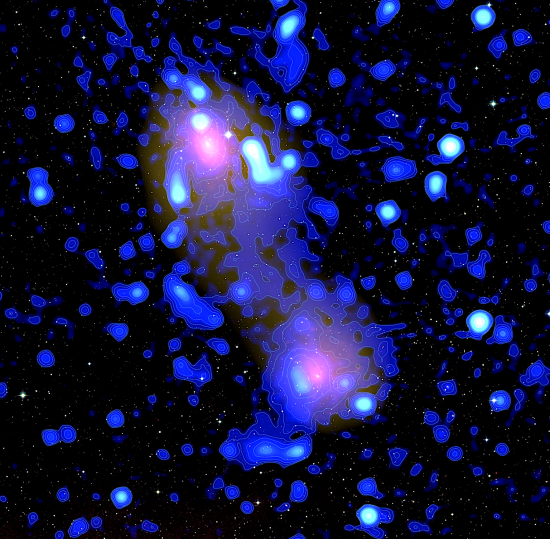
Jun 7, 2019
The idea that electricity flows through the Universe is commonly met with resistance in today’s consensus.
According to a recent press release, two galaxy clusters are connected by a “…peculiar ridge of radio waves linking those clusters, like a thread strung between galactic beads.” Astrophysicists believe that the radio ridge is “…one of the filaments in the so-called cosmic web…”
Plasma between the Clusters Abell 0399 and Abell 0401 is thought to highlight the existence of a structure that connects all galaxies in the Universe. The cosmic web is believed to consist of gravitationally bound conglomerations of galaxy clusters and superclusters, with vast voids between them.
It is extremely difficult for astronomers to map galaxy clusters, since the nearest one to the Local Group that includes the Milky Way is more than 65 million light-years away. As written elsewhere, the density of matter between galaxies can be as low as one atom per cubic meter, so there is not much radiation for detectors to see.
Using the Low-Frequency Array (LOFAR) the research group studied synchrotron emissions that are created when electrons spiral in electromagnetic fields. From an Electric Universe perspective, those fields do accelerate electrons, but that radiation is often identified with X-rays, gamma-rays or radio emissions.
Since galaxies occur in strings, and the extent of their connection with larger circuits can be traced by radio telescopes from their polarized radio noise, plasma’s behavior appears to rely on those (electrical) circuits. Double layers, so often mentioned in these pages, with large potential voltages between them, often exist in those filamentary structures. The electric forces in double layer filaments can be much stronger than gravity. Those filaments can also have different temperatures or densities. Double layers broadcast radio waves over a wide range of frequencies. They can sort galactic gas and dust and then condense it. They can also accelerate charged particles to cosmic ray energies.
As written above, most astronomers use gravity to explain energetic events, like high temperatures in the galaxy clusters. It “must be” because of collisions among its member galaxies in the remote past, or from the merger of two clusters. In the consensus view, Abell 0399 and Abell 0401 are thought to be incredibly hot because molecules of gas and dust crashed into each other, and then condensed into million-light-year strands joining them together.
Their computer simulations assure astrophysicists that what they see “billions of light-years” away can be modeled on the desktop. It is not surprising that observations appear to match their simulations. The concepts used to build computer algorithms are also in the minds of those working with the instruments. Building a device that is designed to see what has been simulated is how modern science works.
Plasma should be thought of as a condition of matter. It is an emergent phenomenon out of complex electrical activity. “Emergent” means: “arising as an effect of complex causes and not analyzable simply as the sum of their effects.” Properties like filamentation, long-range attraction and short-range repulsion, cell-like differentiation, and characteristic instabilities indicate a system of interaction. Therefore, plasmas in space will defy conventional explanation to the point where the laws of physics and cosmological theories will be twisted trying to explain them. Without adding electricity to the mix, a key component in understanding the Universe, theories will remain incomplete.
In his monograph, Cosmic Plasma, Hannes Alfvén described how theory has lost touch with reality:
“The cosmical plasma physics of today…is to some extent the playground of theoreticians who have never seen a plasma in a laboratory. Many of them still believe in formulas which we know from laboratory experiments to be wrong…several of the basic concepts on which theories of cosmical plasmas are founded are not applicable to the condition prevailing in the cosmos. They are ‘generally accepted’ by most theoreticians, they are developed with the most sophisticated mathematical methods; and it is only the plasma itself which does not ‘understand’ how beautiful the theories are and absolutely refuses to obey them…”
Stephen Smith












